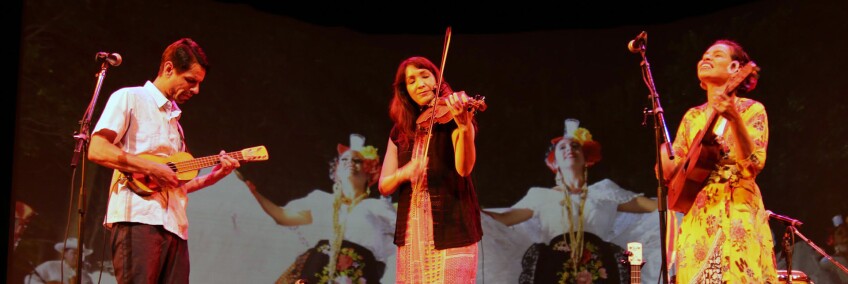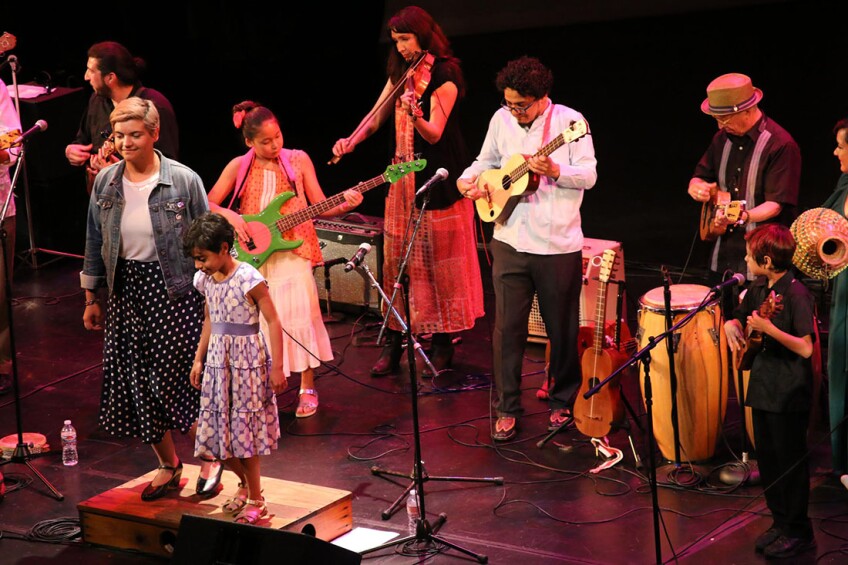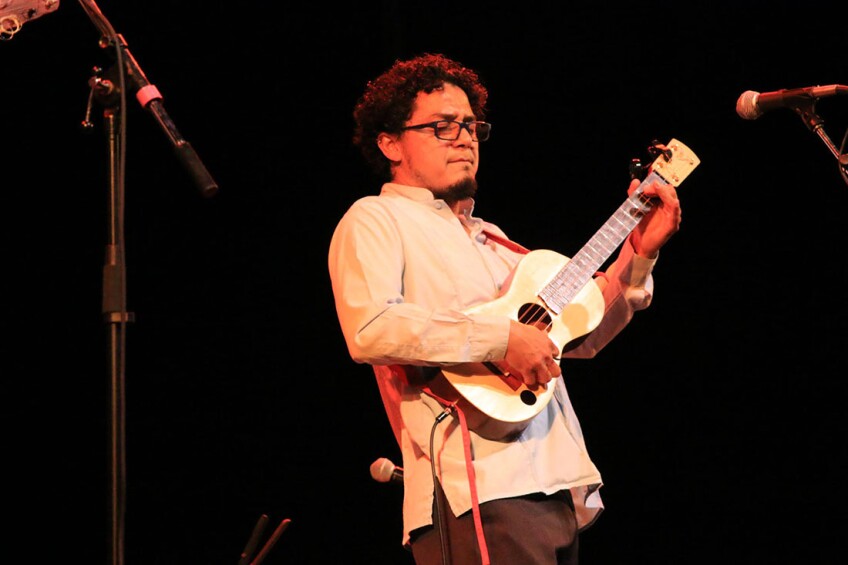From Veracruz to East L.A.: The Evolution of Son Jarocho

At its peak, 24 players crowd around the tarima, a make-shift platform in front of the Aratani Theatre at the Japanese American Culture and Community Center on June 3 for a pre-show fandango, the extended jam session fueled by son jarocho music. Playing a melody in unison on requintos and jaranas (small guitars with four and eight strings, respectively), the musicians watch as two dancers stepped on top of the plywood and set off a percussive, tap-like dance that provided the backbeat of the son (the music). That rhythm is infectious, spreading through the crowd. Even on the first “hot” day of the summer, a couple of crowd members attempt the dance, cheered on by what was an audience, but now feels like a part of the party.
Despite the thousands of miles between downtown Los Angeles and the Mexican state of Veracruz, this fandango wasn’t worlds away from how Cesar Castro, lead singer and founding member of Cambalache, the evening’s headlining act, was first introduced to the traditions of son jarocho.

“[My first fandango] was very warm, very human, very friendly,” he recalls. “The people from the house who were hosting the fandango, they noticed that I hadn’t eaten, and they just told me, ‘sit down and eat.’ I felt very protected and very safe.”
That warm feeling of community has been one of the constants of son jarocho, even as the genre’s music and traditions have spread, migrating from Veracruz to Mexico City and, in the hands of skilled practitioners like Castro, to Los Angeles.
A direct translation of son jarocho may come closest to “Veracruz sound.” The style started in the eastern Mexican state, and the music contains the influences one might expect from a region with one of the most important ports during the colonial era; the stringed instrumentation owes to Baroque, while the time signature and rhythm is indebted to Africa. The percussion comes primarily from dancers, stepping rhythmically on top of a small platform (the tarima).
Accordingly, it is difficult to separate son jarocho from the fandango, the gathering so central to the culture. Sones, the long-form jams played at a fandango, can go for ten minutes or more (at JACCC, the pre-show fandango consisted of two sones over a 35 minute-period), with pairs of dancers tagging in and out, stepping onto the platform to help propel the music forward. In the beginning, that was as far as the music made it: a folk art made to bring friends and family together with sones passed from family to family and town to town by word of mouth.
But eventually, music became both an industry and an art, and the city came calling.
“When the music started to become commercialized in the 1930s, that’s when you started to see musicians play sones that were three minutes long, because now they had these opportunities to make money and move into urban areas,” says Alexandro Hernandez, who earned his PhD in ethnomusicology at UCLA and is a member of jarocho/futurist group ¡Aparato!. “The music started to get taken out of the context of the fandango setting, which wasn’t even a performance – it was outside at someone’s house.”
The golden age of Mexican cinema put son jarocho and the fandango front and center, with artists like Andres Huesca, a harpist, relocating to Mexico City, now with the ability to make a living playing the music. Huesca eventually made the move to Los Angeles (he passed away in the late ‘50s in the San Fernando Valley) and is credited by many as bringing son jarocho with him, performing at major venues like the Million Dollar Theater in downtown L.A.

But son jarocho’s formal introduction to wider America likely came in 1958, when Ritchie Valens recorded a rock-and-roll version of “La Bamba,” one of the older sones, with verses thought to date back to the 1800s. The plugged-in cover peaked at number 22 on the Billboard Hot 100. It was one of the first rock songs sung in Spanish to cross over to American audiences, its existence a shot across the bow of a white-dominated culture.
“The time that it emerged here was McCarthyism, and legal segregation,” Hernandez says. “The places I grew up [Hernandez is originally from Texas], 30 or 40 years before me, signs said ‘No Dogs and No Mexicans.’ … I think anything that didn’t fit into the status quo, at least to the people on the status quo, that was already resistance itself, whether the musicians articulated it that way or not.”
“La Bamba” would figure again in son jarocho’s journey in the late ‘80s, when Los Lobos recorded its version of the son for the soundtrack to the movie of the same name. By then, the music had become not just a tradition on its own, but a part of the musical DNA of several acts. Son jarocho influences, especially through the jarana and requinto, can be seen in the pan-Mexican sound of Jarana Beat, the rock and beat music of Las Cafeteras and the electronic assisted mash-up of ¡Aparato!.
“It’s like being bilingual musically,” Hernandez says of his music’s multicultural influences “We can fuse and take it as far as we want to, but we can also show up to a fandango and hold it down. It’s not like we don’t know the traditional verses – some of us are really good at it. There’s that code switching that exists with us as well.”

In order to add to the tradition, though, one has to understand it. That’s where artists like Castro come in; the master luthier and sonero has taught students in the art of son jarocho in Veracruz, Mexico City, Los Angeles and everywhere in between.
“I’m not trying to repeat the tradition as it is in Veracruz, but we need to keep the most important pillars of what makes son jarocho what we like,” he says. “If we lose that, then it goes off the stage and that’s it. We have more people trying to learn the tradition and trying to learn the social dynamic that comes with the fandango than performers.”
On the evening of June 3, the performers threaten to outnumber the audience at the Cambalache show, even in a near-capacity Aratani. Guests like Hernandez and Louie Perez of Los Lobos round out the numbers on stage. Non-traditional elements, like a rapped verse by emcee Maya Jupiter on an original song, fold into the music seamlessly. And as the show draws to a close, the band and associates are joined on stage by their children, playing bass, dancing on the tarimas, or even singing.

For an evening, it might have felt like those outdoor fandangos in Veracruz. But simply reminiscing about home isn’t on Castro’s agenda.
“I’m not tied to Veracruz,” he says. “I’m expanding Veracruz. It’s not about moving to L.A. to become something different. It’s growing up as a human being, understanding the world a little broader. It is vital, I need that connection, but it’s an extension.”
Top Image: Cambalache and friends performing at the Aratani Theatre | Erick Iñiguez
Dig this story? Sign up for our newsletter to get unique arts & culture stories and videos from across Southern California in your inbox. Also, follow Artbound on Facebook, Twitter, and Youtube.





